The walking tour dedication began at the historic Ambrose Winters memorial fountain in Cooper Park near the Metro Library and ended at the new “Fluid Dynamics” sculpture located in the intersection of Fifth Street with St. Clair Street and Patterson Boulevard.
Along the way, there were remarks by City of Dayton Mayor Gary Leitzell. urban design coordinator John Gower and Sandra Brasington, the Western Ohio Regional Liaison for Governor John R. Kasich.
The Stivers School for the Arts Jazz Quintet entertained the guests.
Here’s what we learned:
Q. What is the Patterson Boulevard Canal Parkway?
A. The project traces the route of the Miami-Erie Canal, once so important to Dayton's commercial and cultural history. The idea is for visitors to walk or bike the historical pathway — a path that today connects Fifth Third Field, RiverScape and the Oregon District — and learn more about Dayton history along the way.
Q. How was the project funded?
A. An Ohio bill, passed during the 127th General Assembly, set aside over $40 million for cultural projects throughout the state. The State's Cultural Facilities Commission has given $2 million to the local project.
“The $2 Million from the Cultural Facilities Commission is for construction only,” explains Amy Walbridge, of the City of Dayton’s office of economic development. “Major elements included sidewalks, lighting, landscaping, and pylon construction from the NE corner of Patterson at Second Street to the SE corner of Patterson at Sixth Street as well as Winter Monument refurbishments, and lighting around McKinkey Stature.”
The City, said Walbridge, covered the cost of all design fees, including the landscape architect, historian and installation of Fluid Dynamics, and also constructed the up-lit base on which the new sculpture rests.
About the sculpture
Q. What's the background behind the sculpture?
A. Bill Pflaum of Kettering has always believes that public art is important in the life of a city.
“When I think of towns where I’ve been, cities that have a life to them, I think of the sculpture and architecture,” explained Pflam, who approached other members of his family about donating a piece of public sculpture. The family’s Dayton roots date back to the 1800s; from 1885 to 1968 they ran George A. Pflaum Publishing, Inc.
“My grandfather, father and brother were all born in downtown or across the river from downtown, and I wanted it to be a family project,” explained Bill Pflaum. Relatives responded with enthusiasm, donating $55,000 for the project.
Fifteen family members came from throughout the country for the recent dedication.
“You may think this is art but it’s also part of economic development for the city,” said Mike Erwin, co-chair of the Downtown Dayton Partnership, who said businesses and organizations want to locate where people want to be, in a convenient and thriving downtown.
Q. How was an artist chosen?
A. Pflaum said the family was looking for a dynamic sculpture that would thematically look to the past, present and future.
“So often monuments just look backwards,” he said. “A city has to look forward.”
Six project proposals from area sculptors were received and reviewed and Pflaum said all of them were outstanding. He’s hoping his project will inspire others to fund some of the others.
Q. What's the concept behind the sculpture? How was it created? Who created it?
A. Sculptor Jon Barlow Hudson of Yellow Springs was chosen for the project. His work, in metal, stone and other materials, can be seen throughout the Miami Valley and internationally as well — in China, Australia, Ireland, France and Canada.
Among the pieces you’ll recognize are the Double Helix at Wright State University’s Diggs BioScience Building, Synchronicity X at Cedarville University, Paradigm Shift at Sinclair Community College and sculptures at the Mason Sculpture Park in Kettering. There are pieces at Springfield’s United Way and Miller/Valentine.
“For me the sculpture speaks of Dayton’s past at the junction of the Miami, Mad and Stillwater Rivers, of its engineers who mastered the aerodynamics of flight, and of its present continuing aero-space engineering,” Hudson said.
He said his artwork also embodies in sculptural form his interpretation of flow in nature.
“This flow is seen in a multitude of areas: from the vortex in water or in a tree trunk, in swirls and eddies in flowing water, in dust devils in the air and hurricanes in clouds, in spiral nebula, in the veining of marble and granite, the design of the ear, the heart and more.”
Much of his work, like the one for the World’s Fair in Australia, have been fabricated locally at Commercial Metal Fabricators. The company, in Old North Dayton, created “Fluid Dynamics” as well.
The sculpture is made of aluminum sheets cut out by a laser cutting machine, then sanded by the artist to make them safe. The complicated process also involved sand blasting and powder coating; the columns were then bolted onto the foundation.
Q. Why yellow?
A. Hudson, wearing a bright yellow shirt that matched his sculpture at the dedication, said because the environment surrounding the sculpture is subdued, the area needed something more vibrant.
“I tried blue, green, red, but yellow was like a sun in this galaxy,” he explained, describing the hue as a marigold or sunflower yellow.
About the pylons
Q. How many pylons are there? Is it best to start and end at a certain place?
A. The 10 historic interpretive towers, located as near as possible to the sites that are mentioned in their text, are all self-contained so they can be read in any order.They're designed to mark a pedestrian way, Walbridge says the next one is always visible.
The pylons are each 12 feet tall and include maps and historic photos. There are 90 panels in all.
“We selected green because green represents the greening of downtown,” says Walbridge. “The pylon is tall like a canopy tree. Plus it adds color, vibrancy and visual interest.”
You’ll read information about the canal, but also about the changes in the transportation system, land use and development patterns over the past 100 years.
For example:
In 1820, the population of Dayton was steady with about 1,000 residents. In 1830, just two years after the opening of the Miami Canal, the population was almost 3,000, and in 1850, five years after the completion of the Miami-Erie Canal, it stood at about 10,000 residents.
Q. What is the design of the finials on top of the pylons?
A. It's a keelboat, the type of boat that would have been present on the Miami Erie Canal.
Q. Who wrote the text?
A. The Ohio Cultural Facilities Commission required the City to hire a landscape architecture firm and historian to work on this project.
Samiran Chanchani, an architectural historian from HistoryWorks, was responsible for researching and writing the history you’ll read. He’s hoping the information will help revive downtown Dayton.
“It’s important to know what happened before, especially in a city like Dayton that set a precedent for progress,” he insists. “We all know about the Wright Brothers, but Dayton is so much more than the Wright Brothers.”
About the Author


